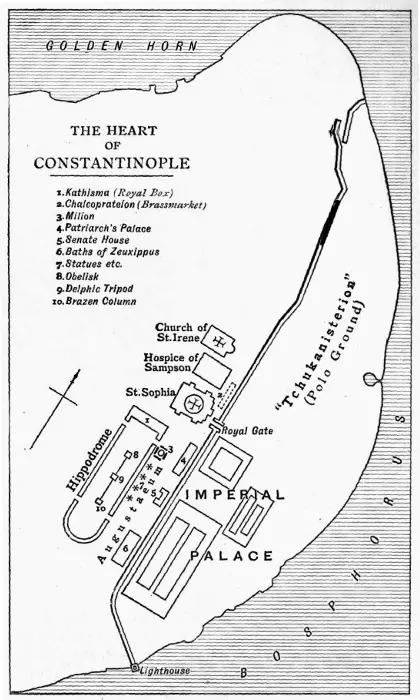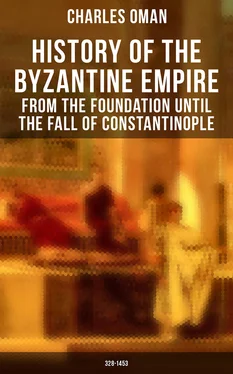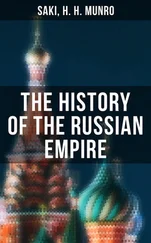For more than a hundred years Rome had been a most inconvenient residence for the emperors. The main problem which had been before them was the repelling of incessant barbarian inroads on the Balkan Peninsula; the troubles on the Rhine and the Euphrates, though real enough, had been but minor evils. Rome, placed half way down the long projection of Italy, handicapped by its bad harbours and separated from the rest of the empire by the passes of the Alps, was too far away from the points where the emperor was most wanted—the banks of the Danube and the walls of Sirmium and Singidunum. For the ever-recurring wars with Persia it was even more inconvenient; but these were less pressing dangers; no Persian army had yet penetrated beyond Antioch—only 200 miles from the frontier—while in the Balkan Peninsula the Goths had broken so far into the heart of the empire as to sack Athens and Thessalonica.
Constantine, with all the Roman world at his feet, and all its responsibilities weighing on his mind, was far too able a man to overlook the great need of the day—a more conveniently placed administrative and military centre for his empire. He required a place that should be easily accessible by land and sea—which Rome had never been in spite of its wonderful roads—that should overlook the Danube lands, without being too far away from the East; that should be so strongly situated that it might prove an impregnable arsenal and citadel against barbarian attacks from the north; that should at the same time be far enough away from the turmoil of the actual frontier to afford a safe and splendid residence for the imperial court. The names of several towns are given by historians as having suggested themselves to Constantine. First was his own birth-place—Naissus (Nisch) on the Morava, in the heart of the Balkan Peninsula; but Naissus had little to recommend it: it was too close to the frontier and too far from the sea. Sardica—the modern Sofia in Bulgaria—was liable to the same objections, and had not the sole advantage of Naissus, that of being connected in sentiment with the emperor's early days. Nicomedia on its long gulf at the east end of the Propontis was a more eligible situation in every way, and had already served as an imperial residence. But all that could be urged in favour of Nicomedia applied with double force to Byzantium, and, in addition, Constantine had no wish to choose a city in which his own memory would be eclipsed by that of his predecessor Diocletian, and whose name was associated by the Christians, the class of his subjects whom he had most favoured of late, with the persecutions of Diocletian and Galerius. For Ilium, the last place on which Constantine had cast his mind, nothing could be alleged except its ancient legendary glories, and the fact that the mythologists of Rome had always fabled that their city drew its origin from the exiled Trojans of Æneas. Though close to the sea it had no good harbour, and it was just too far from the mouth of the Hellespont to command effectually the exit of the Euxine.
Byzantium, on the other hand, was thoroughly well known to Constantine. For months his camp had been pitched beneath its walls; he must have known accurately every inch of its environs, and none of its military advantages can have missed his eye. Nothing, then, could have been more natural than his selection of the old Megarian city for his new capital. Yet the Roman world was startled at the first news of his choice; Byzantium had been so long known merely as a great port of call for the Euxine trade, and as a first-class provincial fortress, that it was hard to conceive of it as a destined seat of empire.
When once Constantine had determined to make Byzantium his capital, in preference to any other place in the Balkan lands, his measures were taken with his usual energy and thoroughness. The limits of the new city were at once marked out by solemn processions in the old Roman style. In later ages a picturesque legend was told to account for the magnificent scale on which it was planned. The emperor, we read, marched out on foot, followed by all his court, and traced with his spear the line where the new fortifications were to be drawn. As he paced on further and further westward along the shore of the Golden Horn, till he was more than two miles away from his starting-point, the gate of old Byzantium, his attendants grew more and more surprised at the vastness of his scheme. At last they ventured to observe that he had already exceeded the most ample limits that an imperial city could require. But Constantine turned to rebuke them: “I shall go on,” he said, “until He, the invisible guide who marches before me, thinks fit to stop.” Guided by his mysterious presentiment of greatness, the emperor advanced till he was three miles from the eastern angle of Byzantium, and only turned his steps when he had included in his boundary line all the seven hills which are embraced in the peninsula between the Propontis and the Golden Horn.
The rising ground just outside the walls of the old city, where Constantine's tent had been pitched during the siege of a.d. 323, was selected out as the market-place of the new foundation. There he erected the Milion , or “golden milestone,” from which all the distances of the eastern world were in future to be measured. This “central point of the world” was not a mere single stone, but a small building like a temple, its roof supported by seven pillars; within was placed the statue of the emperor, together with that of his venerated mother, the Christian Empress Helena.
The south-eastern part of the old town of Byzantium was chosen by Constantine for the site of his imperial palace. The spot was cleared of all private dwellings for a space of 150 acres, to give space not only for a magnificent residence for his whole court, but for spacious gardens and pleasure-grounds. A wall, commencing at the Lighthouse, where the Bosphorus joins the Propontis, turned inland and swept along parallel to the shore for about a mile, in order to shut off the imperial precinct from the city.
 The Heart of Constantinople
The Heart of Constantinople
North-west of the palace lay the central open space in which the life of Constantinople was to find its centre. This was the “Augustaeum,” a splendid oblong forum, about a thousand feet long by three hundred broad. It was paved with marble and surrounded on all sides by stately public buildings. To its east, as we have already said, lay the imperial palace, but between the palace and the open space were three detached edifices connected by a colonnade. Of these, the most easterly was the Great Baths, known, from their builder, as the “Baths of Zeuxippus.” They were built on the same magnificent scale which the earlier emperors had used in Old Rome, though they could not, perhaps, vie in size with the enormous Baths of Caracalla. Constantine utilized and enlarged the old public bath of Byzantium, which had been rebuilt after the taking of the city by Severus. He adorned the frontage and courts of the edifice with statues taken from every prominent town of Greece and Asia, the old Hellenic masterpieces which had escaped the rapacious hands of twelve generations of plundering proconsuls and Cæsars. There were to be seen the Athene of Lyndus, the Amphithrite of Rhodes, the Pan which had been consecrated by the Greeks after the defeat of Xerxes, and the Zeus of Dodona.
Adjoining the Baths, to the north, lay the second great building, on the east side of the Augustaeum—the Senate House. Constantine had determined to endow his new city with a senate modelled on that of Old Rome, and had indeed persuaded many old senatorial families to migrate eastward by judicious gifts of pensions and houses. We know that the assembly was worthily housed, but no details survive about Constantine's building, on account of its having been twice destroyed within the century. But, like the Baths of Zeuxippus, it was adorned with ancient statuary, among which the Nine Muses of Helicon are specially cited by the historian who describes the burning of the place in a.d. 404.
Читать дальше

 The Heart of Constantinople
The Heart of Constantinople










